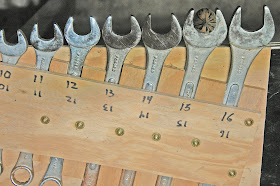Last week we had a light snow fall that covered the pecan grove with about two inches of wet snow (photo at right). The snow turned out to be only .16 inches of precipitation but the cold weather that followed meant that the orchard floor stayed snow covered and wet for several days. Wet soil conditions means that I was unable to finish harvesting my pecans. So, I parked the tractors and moved inside to start cracking nut samples I had collected from the pecan breeding block.
At shuck split, I collected at least 25 nuts from each tree. I let these nuts air dry for several weeks then began the process of measuring, weighing, and cracking nuts.
The first step in my evaluation process is to record the diameter size class of each nut in the sample. I do this because every nut ever brought to a shelling plant is run through a nut sizer in preparation for cracking. Pecans are sized by a series of steel cages with various size slots for nut to fall through. The sizes are recorded in sixteenth of an inch increments. A size 12 pecan falls through an opening 12/16 or 3/4 of an inch wide. I use a series of end wrenches (measured in 1/16 increments) to simulate the nut sizing process (photo above). In the photo, note a nut stuck in the 15/16 wrench. This same nut passed easily between the jaws of the 16/16 wrench (1 inch) and would be classed as a number 16 diameter pecan. By measuring every nut in a sample I can develop a size profile for each clone. The sample I was processing when I snapped these pictures was 50% size 15 and 50% size 16 nuts.
The next step in my nut evaluation process is to weigh 10 randomly selected pecans. This weight will give me an average nut weight but can also be used to calculate average nuts/pound. I use a gram scale to weight the nuts (photo at right). This sample weighed 101.97 grams. This nut averages 10.197g per nut and if you divide the conversion factor of 453.6 by the average nut weight in grams you'll find that this particular pecan averages 44.48 nuts/lb.
With the inshell nuts weighed, I next use a hand cracker and shelling tool to extract the kernels from the shell. In cracking the nuts, I use a light touch because I take great care in trying to extract full kernel halves from every nut.
Once all the kernels are removed from the ten nut sample, I weight the kernels. This sample had kernels that weighed 54.91 grams. By dividing the kernel weight by the nut weight and multiplying by 100, I can calculate the percent kernel for this nut sample. In this case the math works out like this: (54.91/101.97)*100=53.85% kernel.
In addition to the hard numbers that I record on nut size, weight and percent kernel, I take notes on kernel color, ease of extracting full halves, adherence of shell packing material, and any glaring kernel defects.
As I collect this information year after year, I should be able to recognize those trees that produce quality pecans every year. Hopefully, that will lead to some new cultivars.




